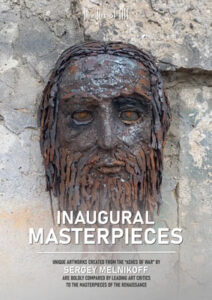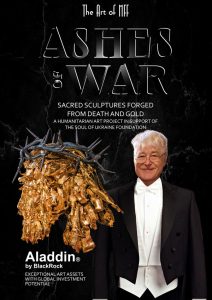The Art of MFF
Ashes of War
Fragments of Redemption
Sergey Melnikoff, a.k.a. MFF, pioneers a new movement in contemporary art, transforming fragments of ammunition retrieved from active combat zones into sculptures that embody victory over evil—imbuing lethal metal with spiritual resonance.
Each sculpture presented on this website is the result of a one-of-a-kind technique, pioneered by MFF, in close collaboration with Ukrainian welding virtuoso Viktor Bielchyk. They are made from fragments of artillery shells and mines collected from active combat zones across Ukraine.
The photo below, taken in MFF’s workshop, shows two tons of cast-iron shrapnel gathered from a single farmland field in the Kherson region. This “ash of war” was sown into Ukrainian soil by the arrival of the Russian “liberators.”
It is precisely these silent witnesses to immense human tragedy that become the raw material for our works of art.
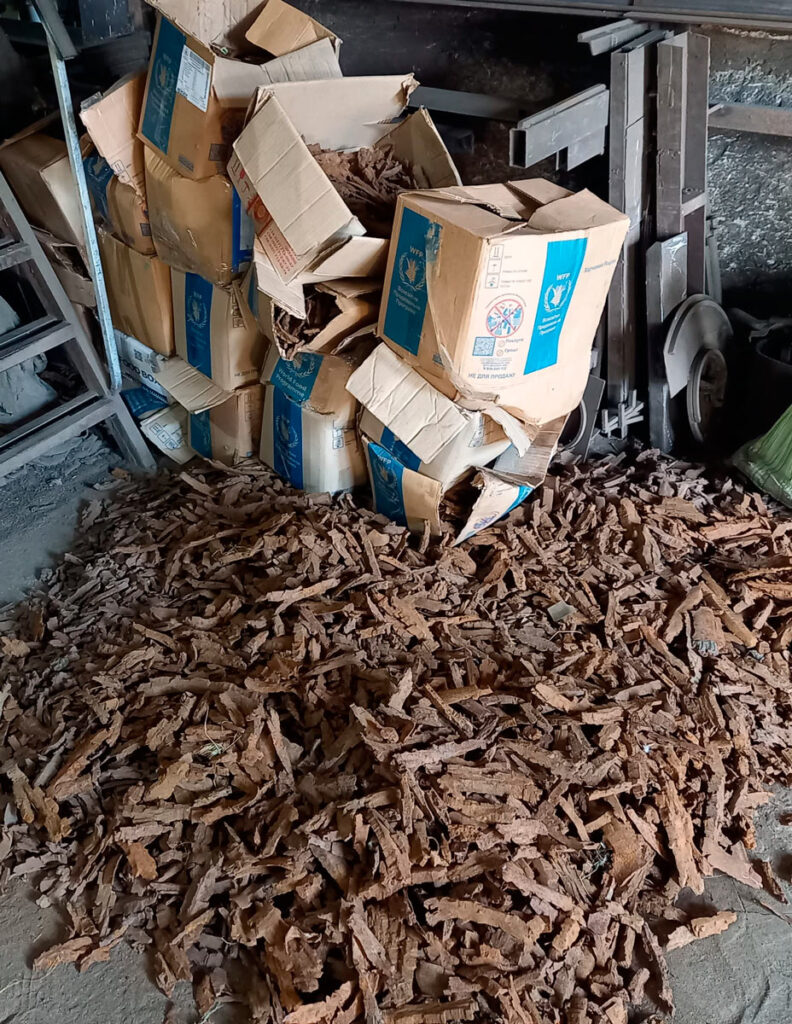
This photo from the artist’s studio shows two tons of cast-iron fragments from artillery shells and mines collected from just one farmer’s field in the Kherson region of Ukraine. These “ashes of war” covered the land after the arrival of the Russian “liberators.” It is precisely such witnesses of immense human suffering that serve as the raw material for the artworks of MFF.
Ashes of War as a Mirror of Our Time: The Impact of Sergey Melnikoff’s Works on Contemporary Art
American artist and photojournalist Sergey Melnikoff, known in the art world as MFF, has emerged as a defining voice in contemporary anti-war art. His series “Ashes of War” is not simply a collection of installations—it is a moral statement forged from the literal wreckage of conflict. Working with thousands of real fragments of death—splinters of mines, artillery shells, charred weapons, and the twisted steel of armored vehicles—Melnikoff transforms devastation into sacred forms.
Among his most iconic works are the monumental Golden Crucifixion, the haunting Holy Mandylion, and the symbolic Ukrainian Phoenix—each constructed by hand from thousands of microfragments of battlefield debris. These are not just artworks; they are material prayers. They speak not only of suffering but of spiritual transcendence through art.
Material as Manifesto
Where others see destruction, Melnikoff sees testimony. His medium is the aftermath of war itself: burnt steel, shattered glass, bullet-riddled armor. By meticulously assembling these fragments into sacred sculptures, the artist elevates raw trauma into sacred symbolism. This is not merely an innovative approach to materiality—it is an ethical reimagining of the role of the artist.
The “Ashes of War” series takes art beyond abstraction and into the realm of radical realism. These works do not allow the viewer to remain distant. They are direct, visceral, and uncomfortable. And therein lies their power.
The Aesthetics of Pain and Catharsis
Melnikoff’s art refuses to comfort. It demands a response—not of admiration, but of confrontation. His sculptures are not decorative; they are wounds cast in iron, designed to awaken memory, conscience, and empathy.
In the tradition of artists like Christian Boltanski, Joseph Beuys, and Anselm Kiefer, Melnikoff uses materials as witnesses. But his voice is more urgent, more surgical. His sculptures do not reflect quietly on past tragedies—they shout about present horrors. His Golden Crucifixion, for instance, made entirely of mine fragments and plated in pure gold, is both a symbol of sacrifice and a luminous indictment of mankind’s descent into barbarism.
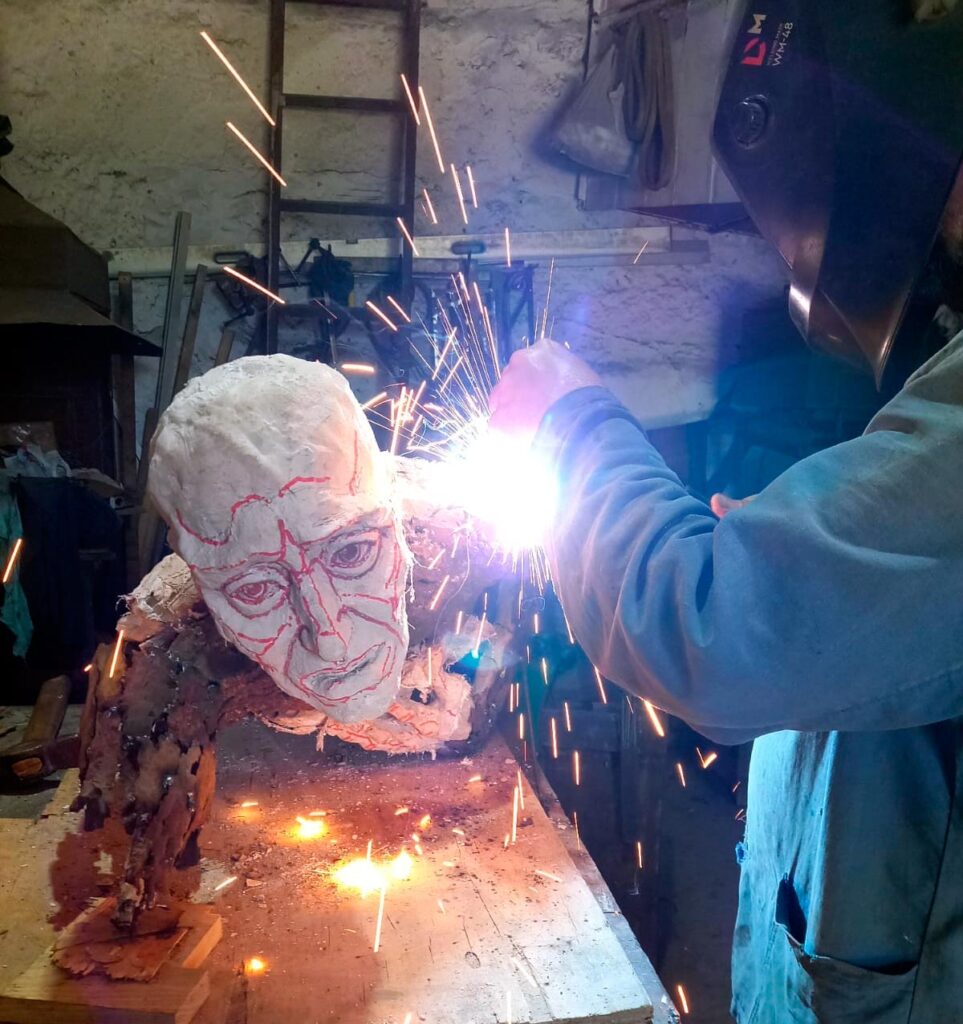
The Art of MFF | On August 5, 2025, amid the relentless terror of war, Sergey Melnikoff and master welder Victor Bielchyk began creating a monumental sculpture titled The Silent Uprising of an Angel in their studio in Odesa.
Photo by MFF
A Political and Spiritual Gesture
The “Ashes of War” project transcends art. It functions as a political and spiritual intervention. Melnikoff’s works have been exhibited not only in art spaces but at international forums, diplomatic institutions, and commemorative events. Each piece is a universal narrative of loss, courage, and spiritual resistance, anchored in the Ukrainian context but resonant far beyond its borders.
This is not protest art in the simplistic sense. It is art as moral witness—art that memorializes not just what was lost, but what must never be forgotten.
Impact on Contemporary Artistic Trends
Sergey Melnikoff’s work represents a new wave of material activism in art. His method—a radical fusion of documentation, symbolism, and sacred geometry—challenges the conventions of both gallery aesthetics and curatorial frameworks. His pieces confront the modern art world with the question: what is the role of the artist in the face of genocide, injustice, and war?
In doing so, Melnikoff is helping shape a broader movement toward what might be called spiritual realism—an artform that is neither escapist nor nihilistic, but rooted in moral urgency and human dignity. His influence is visible in how institutions are reevaluating the importance of memory, truth, and ethical engagement in contemporary practice.
Conclusion
“Ashes of War” is not just a series of installations. It is a requiem cast in steel. It is art born of destruction, but forged with compassion and hope. In a world where war has become a background noise, Sergey Melnikoff forces us to listen—to see, to feel, to remember. His works transform the debris of violence into the language of redemption.
And in doing so, they do more than change the face of contemporary art.
They change us.
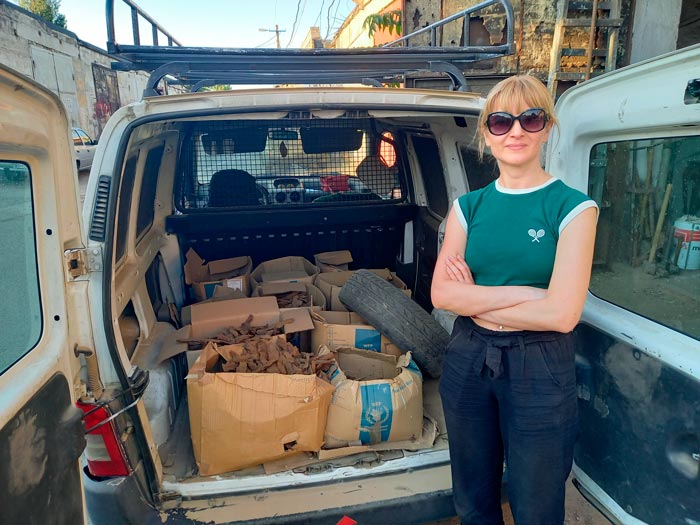
Artist and Daughter Face Mortal Danger While Transporting War Debris for Art Project
Photo caption: Anastassia stands beside the vehicle she used to transport hundreds of kilograms of war debris to her father’s workshop in Odesa. July 11, 2025
In a chilling episode underscoring the constant threat of war in southern Ukraine, Sergey Melnikoff and his daughter, Anastassia, narrowly escaped a potentially deadly encounter while transporting 500 kilograms of shrapnel fragments through the Kherson region.
Anastassia had traveled to Ukraine to attend both a press conference at Ukrinform and to celebrate her father’s 70th birthday. But their journey took a perilous turn when, not far from the village of Zelenyi Hai—where the shrapnel had been collected for Melnikoff’s latest icon—an enemy combat drone appeared overhead, hovering ominously in search of a target.
Just days earlier, in a nearby village, a one-year-old child was killed by a Russian drone strike. The New York Post reported on the tragedy, stating: “This was no accident, but a deliberate killing. Kherson is now a zone of human safari.”

The Art of MFF | The Holy Mandylion is more than a symbolic representation of faith, the work constitutes a form of spiritual transformation—an artistic transmutation of war debris into a sacred object.
In the photo: Chaplains Andriy Yaniv, Yurii Parfaniuk, and Roman Khorbutii with the iron icon The Holy Mandylion in Borodianka. July 9, 2025.
Photo by MFF
Toward the Tragedy of the Ukrainian People
Dear Esteemed Supporters,
For over three years, we have worked with unwavering dedication toward a singular humanitarian mission: to establish a sanctuary in Albania—a place of healing, hope, and renewal for Ukrainian children whose lives have been irreparably affected by the brutal war waged by the Russian Federation.
What we present to you today is more than art. It is a series of sacred objects—sculptures forged from the very remnants of war. These works, titled Ashes of War, are crafted from fragments of artillery shells, mortar casings, and other metallic remains collected from active combat zones across Ukraine.
From these cold, lifeless fragments, beauty and meaning have emerged.
Each piece bears silent witness to immense human suffering: the destruction of homes, the cries of children, the anguish of mothers, and the resilience of a nation that refuses to be broken. These are not simply works of art—they are testaments to survival, vessels of remembrance, and symbols of transformed love.
All proceeds from the sale of these sculptures will go directly toward the creation of the Mother Teresa Center—a charitable facility dedicated to supporting Ukrainian children affected by war. This center will offer not only shelter and medical care, but also psychological healing, education, and the nurturing of joy, dignity, and trust.
With your support, this vision can become a reality.
On behalf of the children we serve and the future we strive to rebuild, we extend our deepest gratitude for your compassion and commitment to a world where love and resilience triumph over destruction.
With sincere thanks,

Sergey Melnikoff
A Photo Gallery
The Art of MFF | The Making of a monumental sculpture titled The Silent Uprising of an Angel.
Sculptures from Ammunition Fragments: Art on the Edge of Memory and Protest
Sergey Melnikoff, known as MFF, creates sculptures from authentic fragments of mines, shells, and bullets collected on the battlefields of the ongoing war in Ukraine. Each of his works is not merely an artistic object but also a tangible testimony to tragedy, encoded in metal that, until recently, carried death.
The uniqueness of these works lies in the fact that the artist uses materials impossible to perceive neutrally. There is no distance between art and reality here: the viewer does not see abstract metal but recognizes in it the twisted fragments of weapons, visually tracing the scars of explosions, burns, and deformations.
In world art, there have been examples of using wartime artifacts — from transforming weapon debris into decorative objects to creating memorial installations. However, Melnikoff’s works stand out for their exceptional sculptural craftsmanship and monumentality. They go beyond a conceptual statement, transforming fragments into anatomically precise forms — crucifixes, icons, figures of angels, and mythical birds.
These sculptures cannot be perceived merely as art objects. They function simultaneously as works of art, historical artifacts, and emotional triggers. There are virtually no direct analogues to this synergy in contemporary world sculpture: Melnikoff does not simply reinterpret found art — he forges a new genre, one that may be defined as Sacred Military Realism.
Global Context and Distinctions
British artist Jeremy Deller created installations from wreckage brought from Iraq, yet his works took the form of conceptual displays without detailed sculptural execution.
Chinese artist Ai Weiwei has incorporated weapons into his installations as political statements, but avoided sacred or hyper-realistic imagery.
German artist Gunter Demnig, with his “Stolpersteine” project, worked with the memory of war victims through urban minimalism rather than monumental figurative sculpture.
Against this backdrop, Sergey Melnikoff’s works stand out in that they combine the physical presence of war, a high level of sculptural mastery, and symbolism capable of resonating on the level of cultural memory for entire generations.
A worldwide patent application covering this technology has been filed and is currently pending. © Sergey Melnikoff, 2025
Related Promotional digital booklets
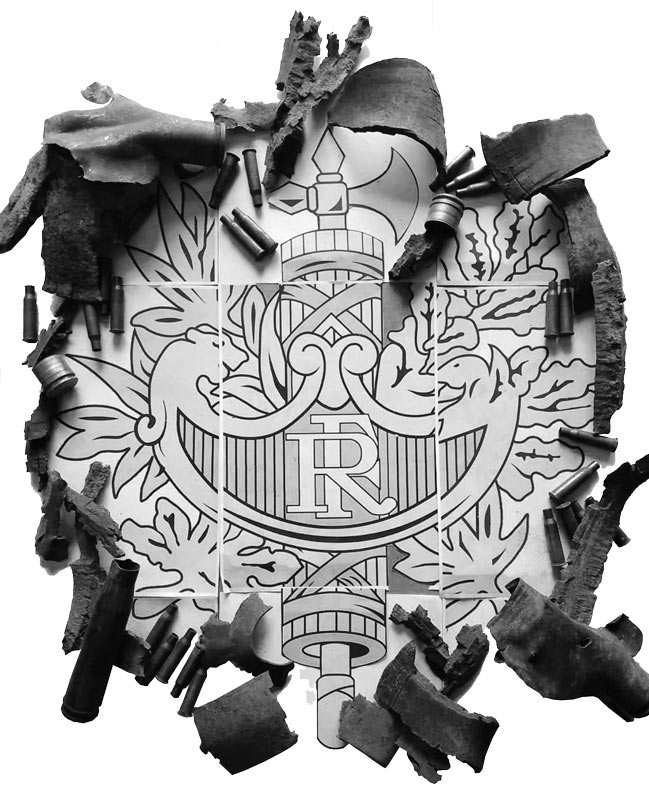
Honor Through Art
If you’re inspired by the unique technique of crafting modern art from the “ashes of war,”
you can commission a custom piece—be it your national emblem or corporate logo.
Ideal for private collections, distinguished gifts, or tributes of national significance.


